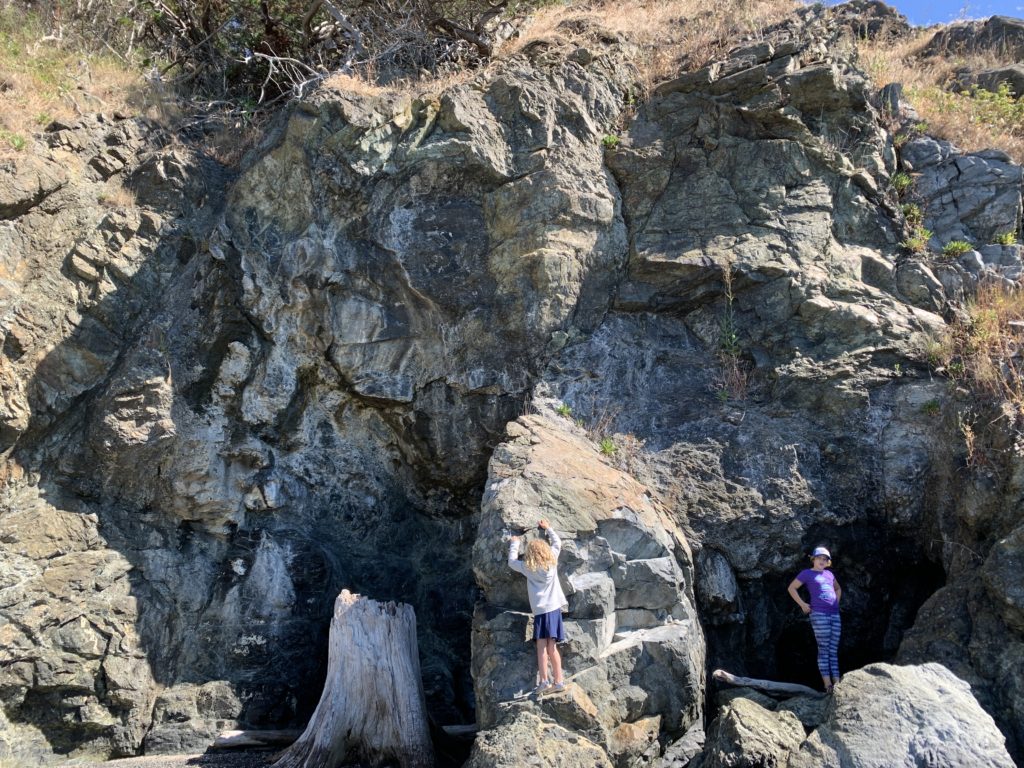We just returned from nine days in the San Juans (~210 miles and 31 hours on the main). They were beautiful and crowded, as always. Of course, we were part of the crowds, so we did our best to embrace the islands as they are, instead of pretending they’re some remote corner of Alaska. This will be a cruising and introspection post. We’ll continue with the maintenance fun soon.
Day One: Liberty Bay to Hope Island (Seven hours). Our biggest challenge for reaching the San Juans is the distance. At around seven knots, you need to spend a day getting up there and a day getting back – and the options for stops are limited (Langley, Port Townsend, La Conner, and Port Ludlow). Of these, only Port Ludlow has good anchorage if the marina is full. I’ve heard tales of places along Camano Island where you can drop the hook in the right conditions, but so far they are just legends.
I pushed it a bit and burned four gallons per hour so we could be set before dark (We normally burn around 2.8). We dropped anchor just south of Hope Island near Deception Pass after a day of cruising in warm sun and calm waters. This is a beautiful, calm anchorage – though the bottom southeast of Hope looks like the badlands on the charts and sonar. The Island itself is primitive, with limited, overgrown trails. The north side has a couple of good dinghy landing beaches, but the south side is more beautiful, with rocky bluffs. We were’t really prepared for bushwhacking, so we mostly stuck to the beaches. I’d like to go back with the right clothing for a longer expedition.
Day Two: Hope Island to Hunter Bay via Deception Pass (Two hours). This was my first time transiting Deception and my first time trying to predict currents instead of just tides. My old, simplistic model was that slack was at high and low tide – but real currents are far more complicated. I used the AyeTides app, the NOAA current models, and another model I found on the web. Unlike the tide predictions, which were consistent across all three, the current predictions varied from model to model — and continued changing over time. In this case, slack was three hours after low tide and four hours before high tide (which seems super weird and I still can’t get my head around). So, we used the average of the predictions, and the water did indeed seem close to slack — and our transit was uneventful. The biggest hazard, as usual, were other boats. Exiting Deception into the Strait was super cool.
Hunter Bay is a lovely, sheltered bay on the SE side of Lopez island. Good holding, beautiful views, and plenty of room — but not much to do on shore. The kids swam off the swim step and we relaxed. This is a great first stop when coming to the San Juans from the south.
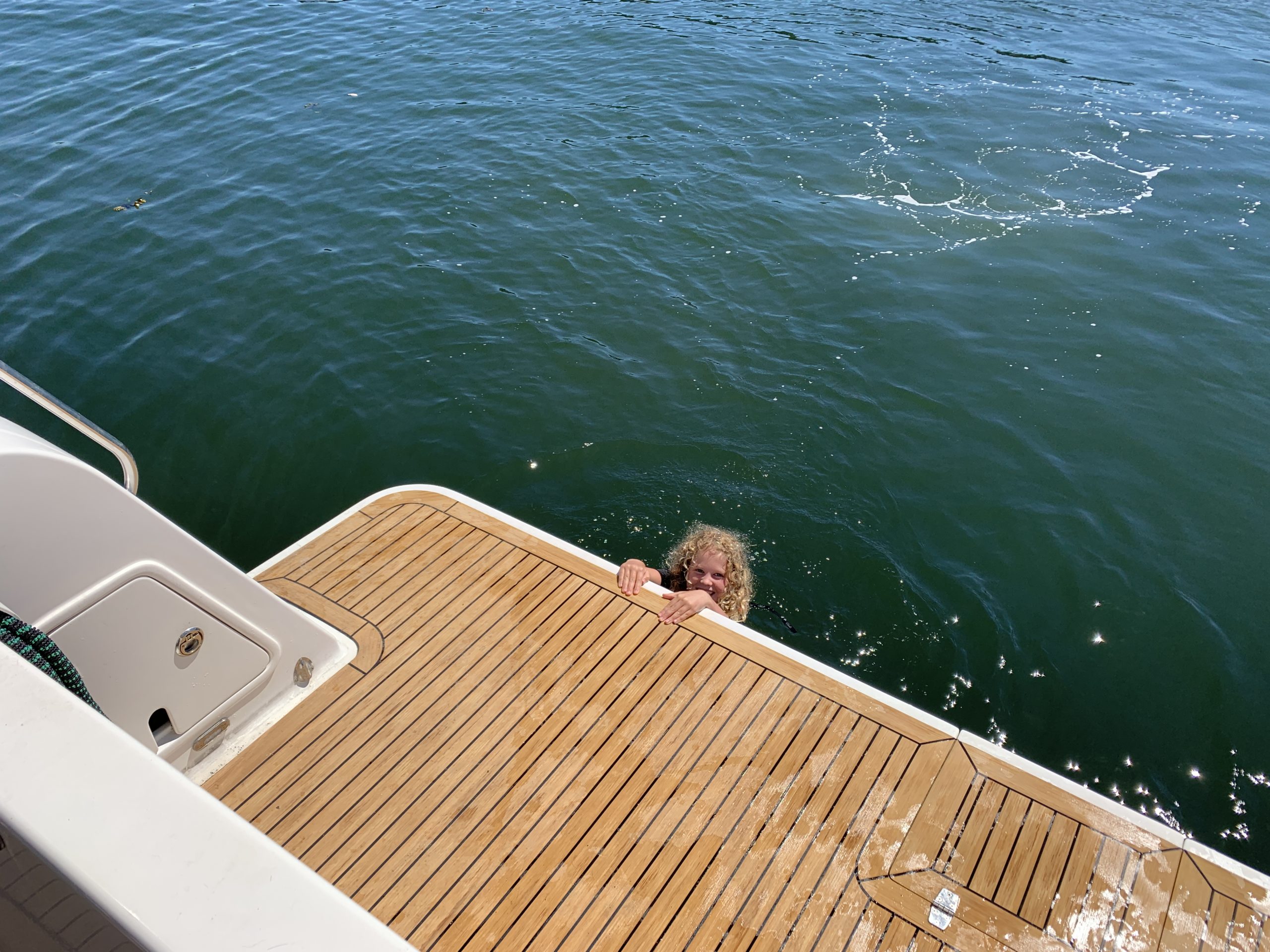

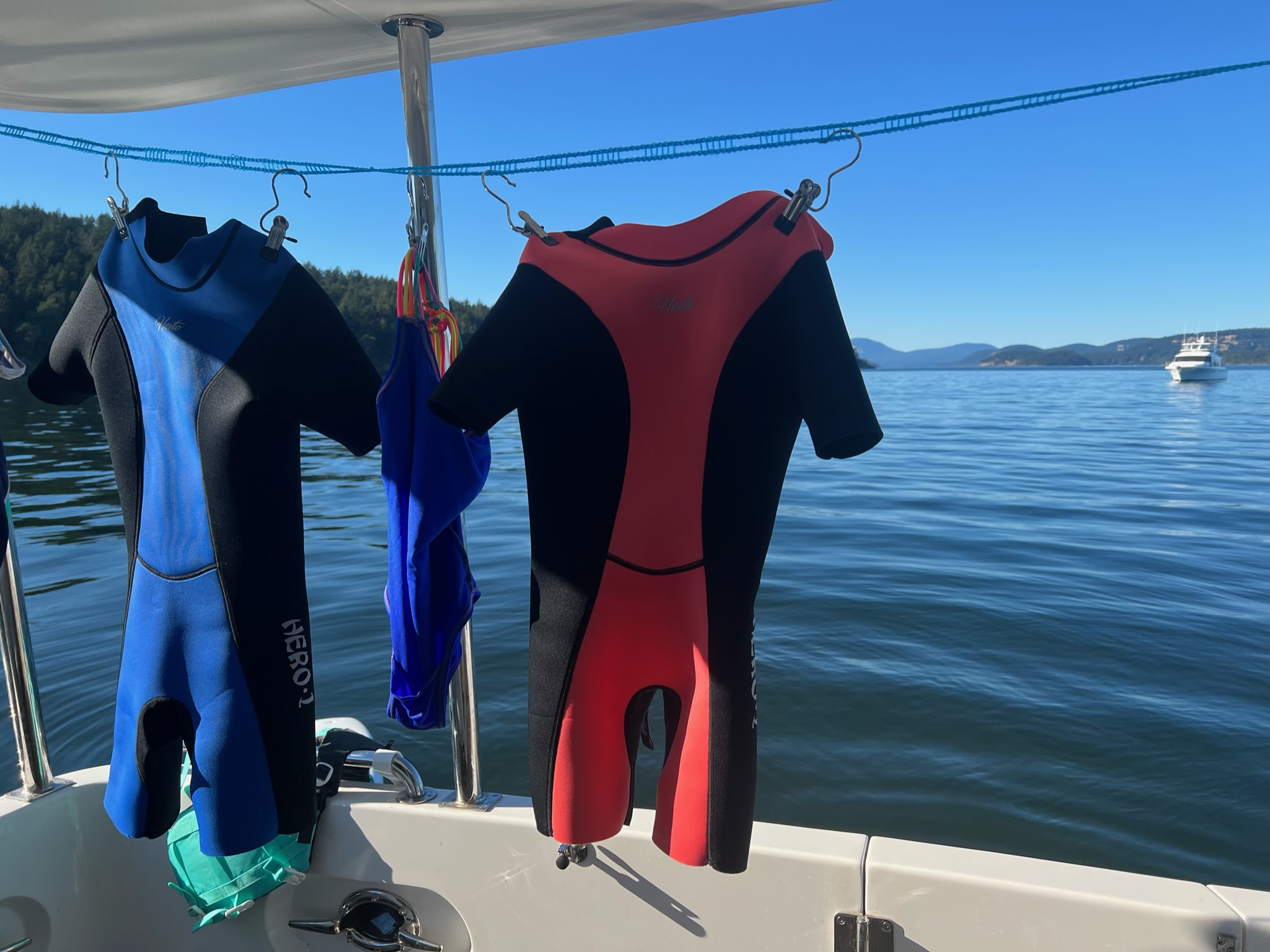

Day Three: Hunter Bay to Friday Harbor (~Three hours). “Are we really going to go to the busiest port in the San Juans and request last-minute moorage?” I was hesitant to fight the craziness of a crowded marina and ferry port, but Friday Harbor turned out to be delightful. They quickly found us a spot on the loading dock and we had a pleasant stay. I felt like we owed the kids some town-time after a couple days of spent mostly on the water. Unlike Roche Harbor, which is a resort, Friday Harbor is an actual town. With all of the ferries coming and going there are a ton of businesses here – a great grocery store and plenty of food options. People were super friendly and we wound up having a great stay. My daughter tried chicken and waffles and it’s her new favorite breakfast. It is definitely busy, so don’t be afraid to use the VHF to talk to the marina.

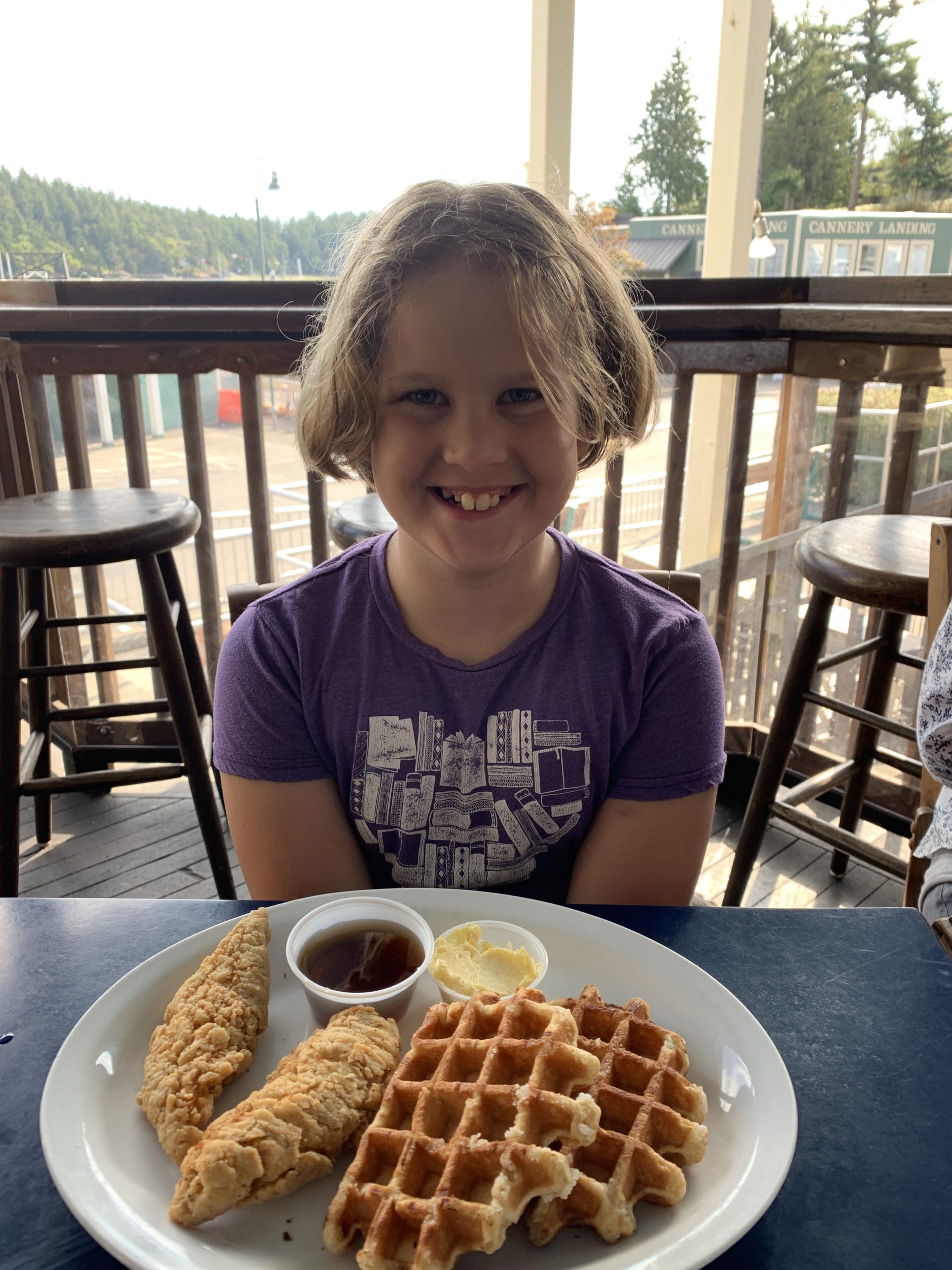


Day Four: Friday Harbor to Echo Bay, Sucia (Two-and-a-half hours). I’m just going to say it: Sucia is overrated. The island is rugged and beautiful, but in the high season it is really busy. I should emphasize that, by high-season standards, Sucia had plenty of room for us (at least in Echo – Shallow and Fossil were full). But, it still feels like a busy State Park, given how remote it is. While there was space for us to tuck back near shore, Echo Bay is still fairly exposed (to the ESE). It’s one of the few places where wave slaps against the side of the hull keep me awake all night (this happened last time we were there, too – small waves on the beam all night). A front moved through on our second day, creating a steady wind and a thunderstorm. While the holding was good, all of the rodes in the bay were pulled tight and the boats were dancing on their hooks. We had dinner with some friends that we happened to run into, took a (gorgeous) day hike to Ewing cove through the storm, and relocated our anchorage when a prime spot in the NW corner opened up. Again, Sucia has a lot to love, but the busyness and exposure take away some of the magic.
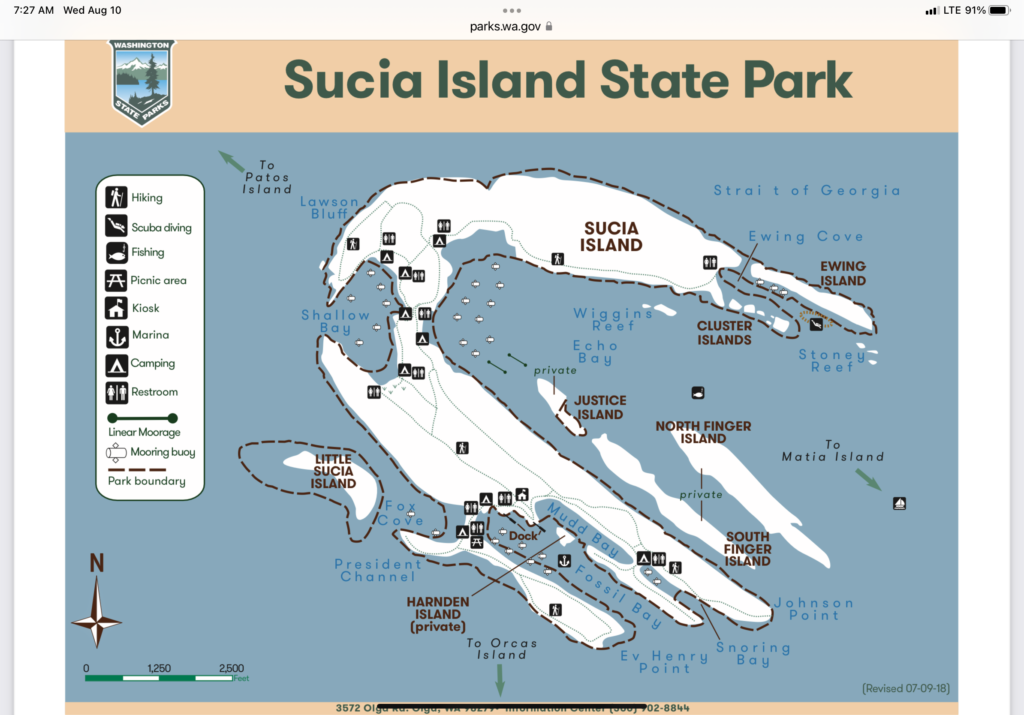
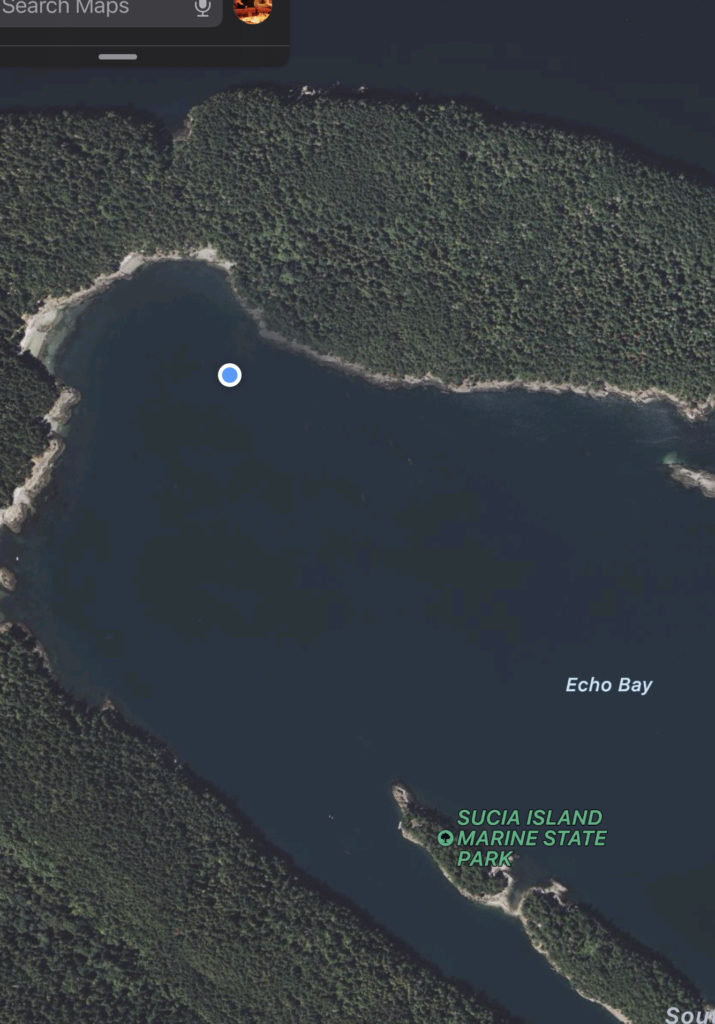

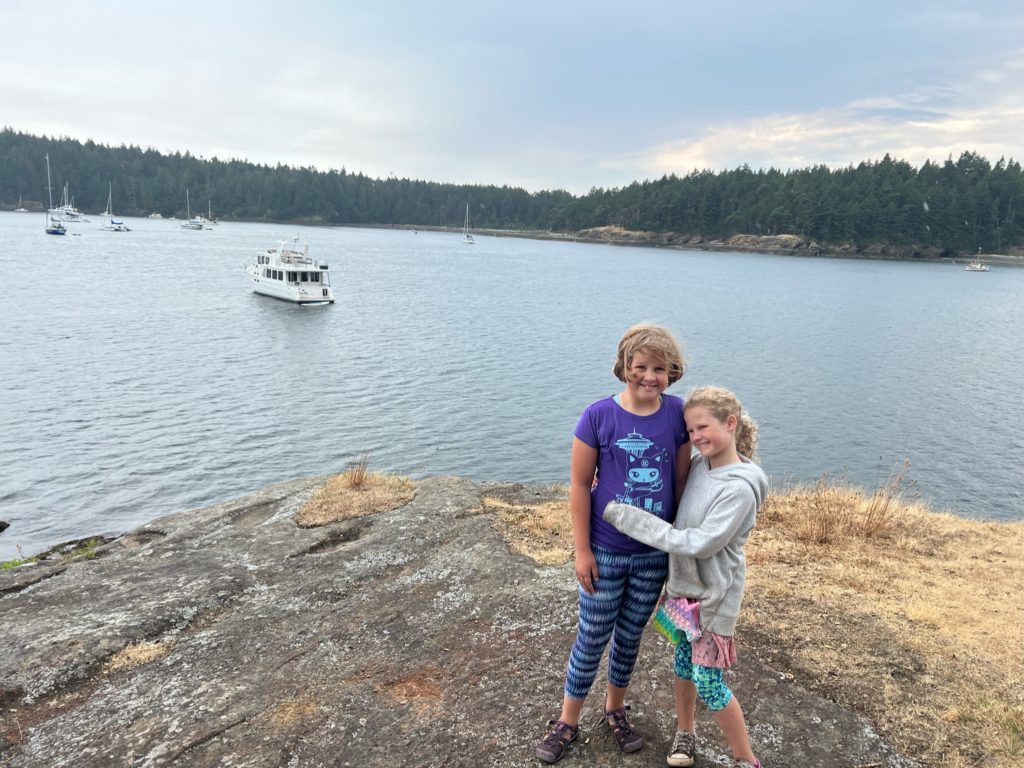


Day Six: Sucia to Wescott Bay Roche Harbor (Three-and-a-half hours). The waterproofing on the iPhone Xs apparently expires. I had it in my pocket when wading the dinghy to and from shore, and the battery puffed up (Not knowing how bad the meltdown would be, I stuck it on some foil in the BBQ). So, no more pics…
We’d planned to anchor in Wescott and get lunch at the famous Shellfish Company, but there were no open tables for days. Wescott and Garrison are often called out as pleasant anchorages with easy access to Roche. But, again, in my experience, they are very packed – with people anchoring on top of each other creating very limited swing room. These bays are also very shallow, making 3:1 scope unreliable. On this visit, we arrived at a -2.7 tide, making the navigable channel very narrow – and this was filled with crab pots. Near the entrance to Wescott, we got down to ~1’ beneath the keel and had to navigate within feet of a large boat that had anchored at the end of the deeper channel just to pass. In Wescott itself, most of the the depth was less than 6’ below the keel, with several bottom obstructions noted on the south side near the Shellfish Company dock. All-in-all, it was a white-knuckle, slow motion mess as we dodged pots, tried to keep off the bottom, and find a decent place to drop the hook with enough swing room. Again, I flat out disagree with the Waggoneer guide, here. These are shallow, crowded anchorages that represent some of the most annoying aspects of cruising the San Juans. So, we puttered out to Roche Harbor and radioed for a spot. We dropped the hook for an hour, after which they called us back and got us a spot on the guest dock. When we pulled up anchor, there was a kelp forest the size of a shopping cart stuck to it — supporting the stories we’ve heard of solid sets suddenly letting go in the night.
I have mixed feelings about Roche, the resort. The staff is friendly and professional and the pool and other amenities are great for families. There are a ton of services and we met some great people. But, the place is also party central. The inner guest dock gets loud and rowdy — starting at 10 am and going past sundown. It’s also just super super busy. It’s like docking your boat in the middle of a party theme park — and we’re not really party people. It’s also the most expensive place to buy pretty much anything. But, we met up with some friends, the kids enjoyed the pool, the staff was really responsive and helpful, and, over-all, we had a good time.
Day Eight: Roche to Port Ludlow (Six-and-a-half hours). This was the first time I’d ever taken the outside path through the Strait of Juan de Fuca. I was really nervous, but we sat down and planned it out leg-by-leg. For each portion, we looked at the currents, wind, and bail-out options. The forecast was good, the currents were on our side, and the wind was light. To our great pleasure (and with some degree of pride) the trip was uneventful. Every thing we’d predicted came to pass — the ebbing tail current through Haro, the moderate waves in the central Strait as the shifting tide pushed against easterly winds, slack shifting to flood just as we passed into Admiralty Inlet to give us a push south to Ludlow. Really beautiful cruise.
We never got off the boat in Ludlow. We dropped the hook (after a lot of confusion about the cable area – it seems to be half of the bay, but most of the boats were anchored right where the charts said not to), and had a relaxing night — played a boardgame and ate mostly leftovers for dinner.
Day Nine: Port Ludlow to Liberty Bay (Four hours). While the tides helped us yesterday, they fought us all the way home. I used it as an opportunity to run the engine harder, rotating through load levels with 10 minutes at max load. It was a beautiful cruise and, while I was tired and looking forward to getting home, I was also sorry the trip was over.
Firsts from this trip:
- Transiting Deception Pass (in almost 20 years of on-and-off cruising, I have always taken Swinomish Channel).
- Setting a low-RPM speed record (13.1 kts at 1500 RPM – that’s normally 7 kts for us in still water).
- Hiking Sucia in a Thunderstorm. It was glorious.
- Crossing the Strait of Juan de Fuca. I’ve taken ferries across before, but this was in my own boat as captain. It’s also the furthest from land we’ve ever been (Smith Island notwithstanding). The closest shore was about seven nm away.
- Transiting Admirality Inlet. I’ve now piloted through all three gates into Puget Sound.
- Docked in our home slip without thrusters. Perfect weather and favorable wind seemed like a good time to practice.


Other notes:
Boat Friends – We met many people along the way. We ran into some friends from our old-old slip, got invited aboard a Nordhavn in Friday Harbor for happy hour and advice about cruising to Alaska (TL;DR get Starlink), made some new friends on the dock in Roche, and met up with our buddy-boat Seapos as she came back from two weeks in Canada. We’re not super social people, but it’s really easy to make friends in this community.
Dog Aboard – Ziggy is turning out to be a great boat dog. While she has her weirdnesses (hesitant swimmer, paralyzing fear of stairs), she took to the boat right away. She used the potty pad on the first attempt, doesn’t freak out in heavy seas, and is content to hang out in her kennel for much of the time. Like all of us, she gets a bit stir crazy when she can’t get to shore for a day or two, but that’s pretty normal for a six-month-old lab. We do need a solution to the pee smell that starts to permeate the cockpit – even with regular cleanings and throwing out the soiled pads. Our friends on the Nordhavn recommended a washing machine tray.
Living Aboard – While we have made tons of progress in seamanship, we haven’t really figured out living aboard. Lots of stuff never gets unpacked and every flat surface is covered with random stuff. Some cabinets are mostly empty while others are over-full and unorganized. We shop at the last minute and bring all the packaging aboard, which then needs to be packed back out or stowed somewhere until we can. We need to apply some program management to living aboard so the boat feels more like a home and less like a hotel room. This means putting commonly needed things in easy-to-access cabinets, deep-stowing situational stuff (the multi-pack of life vests for guests), organizing (where are my spare engine anodes? Where’s the spare impeller? Who knows?) and removing stuff we don’t need. Boats require deliberate planning to declutter.
How to Relax (?) – I had big plans to read my paperbacks, sketch, write haiku… In practice, I spent most days deploying or stowing something, organizing, transporting, disposing of, cooking, hosting, etc. Even on vacation, most days were filled with activity. We talked about it on the way back and neither of us feels like we were doing make-work – everything needed to be done. Example: the pool at Roche is a long walk from the guest dock, but a short paddle or dinghy ride. We didn’t deploy our dinghy before backing in. So, walking everyone over, getting the kids in the pool, parent #1 takes the dog back to the boat while the other stays with the kids. Parent #1 grabs Parent #2’s swim suit and gets the idea to drop the paddle board so it’s faster to get back. This takes 10-15 minutes. Parent #1 crates the dog and paddles over with supplies to relieve Parent #2, who paddles back to the boat. The whole exchange took like an hour. I spoke to the captain (dad) of Seapos and he felt the same way. With all their water toys and gear, he spent a good two hours of every morning just messing with stuff. This is a topic for more thought. Busywork is the enemy of a good vacation…
Next up – everything that broke — and what I I did about it!

